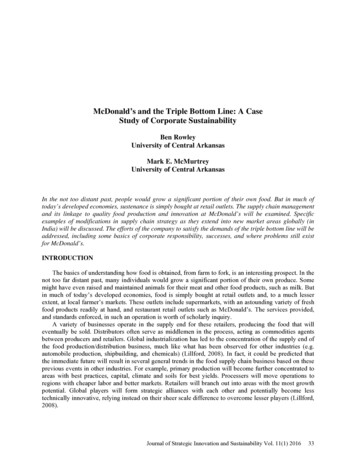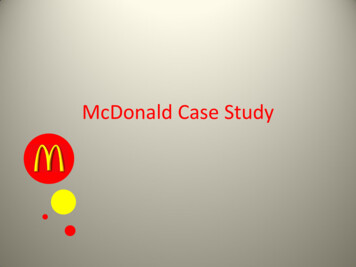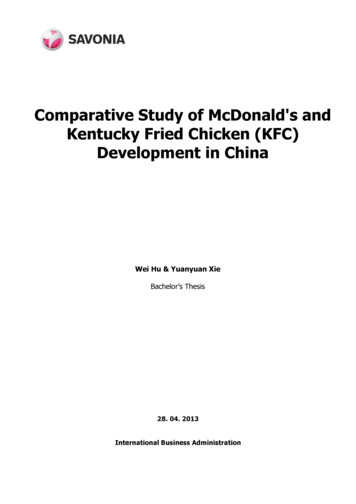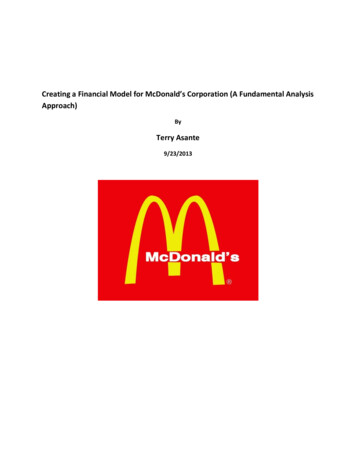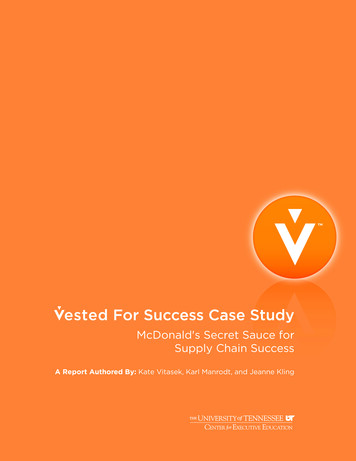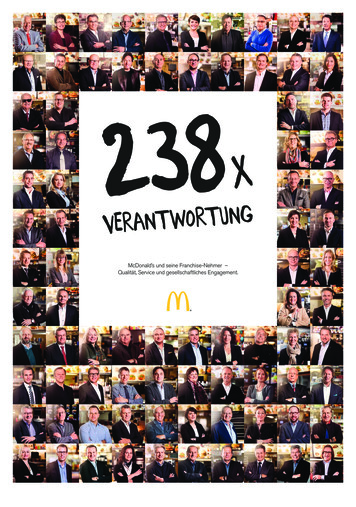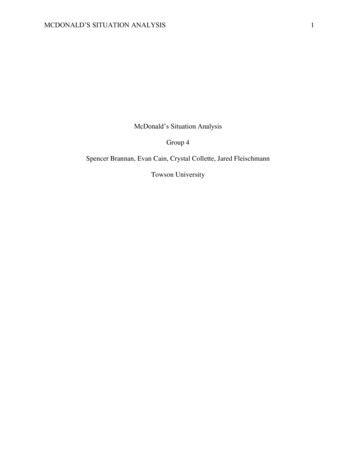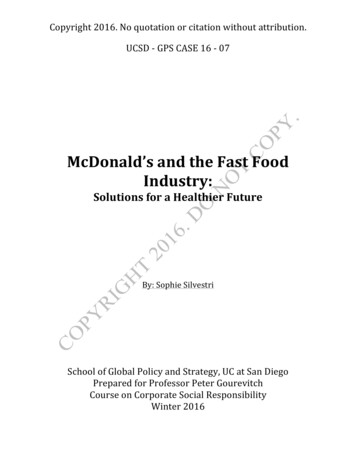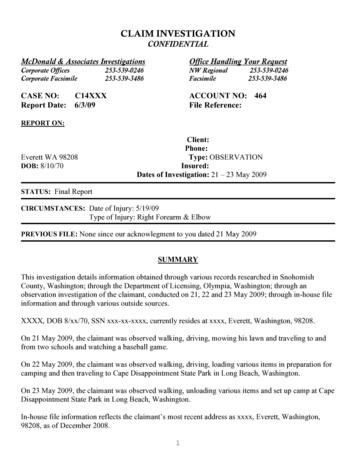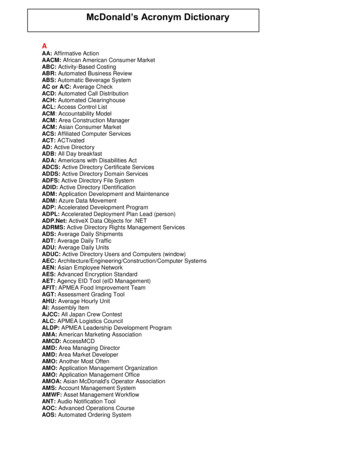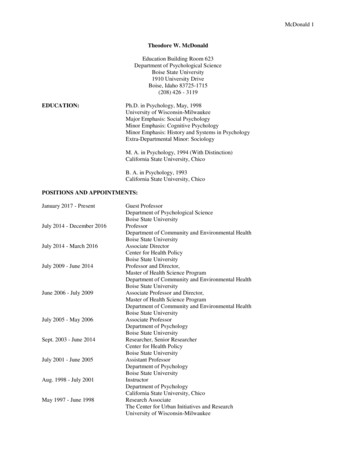
Transcription
Asia Pacific Journal of Marketing & Management Review ISSN 2319-2836Vol.2 (1), January (2013)Online available at indianresearchjournals.comA CASE STUDY ON MCDONALD’S SUPPLY-CHAIN IN INDIAKSHITIZ SHARMAAssistant Professor at Alliance School of Business, BengaluruABSTRACTMcDonald‟s is the world leader in QSR. Their presence in 118 countries with 33,000 restaurantsglorifies its position as world leader and as fast food giant. This huge network is not easy tomanage where guest expectations are clean, hygienic, tasty and quick food every time. The creditof this successful availability goes to the unique supply chain management and control over thisentire huge network. McDonald‟s is present in more than 40 cities of India with 250 eatingoutlets and adding more every now and then. This huge supply chain is entirely outsourcedwithout any legal contact with them. Some unique features of this supply chain managements arelean management, multi-layered supply-chain, cold chain, Hub and Spoke system. For trainingtheir staff company takes all its measure through intensive programmes like Supplier QualityManagement Systems (SQMS) and the Distributor Quality Maintenance Program (DQMP). Theexplained model will help to understand the flow of supply chain.KEYWORDS: multi-layered supply-chain, cold chain, Hub and Spoke, SQMS, DQMPINTRODUCTIONMcDonald‟s is a limited menu restaurant is characterised by speed of operations. McDonald‟s isthe world leading retailer with more than 33,000 restaurants in 118 countries serving more than67 million customers each day. In India, the first outlets of the chain threw open their doors tothe public in Delhi and Mumbai in 1996 within one month of each other. McDonald‟s is presentin 40 Indian cities with 250 restaurants and serves 650,000 customers daily.THE FOOD RETAIL INDUSTRYInternationally, no doubt McDonald‟s is considered the largest food service retailer in the world.The first restaurant was established in 1955 in Des Plaines, Illinois, USA. It emerged in Indianterritory in 1996 eyeing the informal dining-out industry in India which is estimated at 74billion a year. The fast food industry in India is estimated to be 12- 14THE INTRICATE SUPPLY-CHAINThe strength of McDonald‟s India employees amounts 9,000 people including restaurant staff.But the surprise lies in its unique and intricate supply chain network which is managed by justfive people across the whole country. Including the Quality Assurance people, this figure rises tojust eight people who are all responsible for its efficient supply chain Indian territory.112
Asia Pacific Journal of Marketing & Management Review ISSN 2319-2836Vol.2 (1), January (2013)Online available at indianresearchjournals.comSUI GENERIS NETWORKThe supply-chain network of McDonald‟s is of its own kinds:100 percent outsourcedLean with no back-up staff and no frills.The company is enjoying growth of 30-40 percent every year in India. The credit goes to theproper research work done before launching McDonald‟s in India. The experts set together andcoordinatedgroundwork was done to ensure the successful functioning of its demand and supplysystem. It was from 1990 onwards, expert teams happened to be in India to check the strength ofIndia‟s logistics industry, the reliability of its transport sector, and resource availability. Theresult was an extremely effective supply-chain at optimal level in place despite of India‟s weakinfrastructure.In context to Indian market special menus with religious and cultural sentiments were designedand in six years time the company was ready with its entire supply chain. McDonald‟s which isknown for its beef burgers free of beef and pork in Indian subcontinent.MULTI-LAYERED SUPPLY-CHAINThe McDonald‟s supply chain is both critical and multi-layered. There are two categories in foodingredients supply;Tier-I and Tier-2 suppliers as reflected from figure 1.In Tier-I there are 14 core suppliers-provide processed products e.g. Vegetable and chickenpatties comes from Vista Processed foods Pvt Ltd. , French fries, potato wedges and hashbrownsby McCain Foods India Pvt. Ltd. And so on.In Tier-2 suppliers there are growers and processors who provide lettuce and potato, poultryitems and coating systems that are used for coating the chicken and vegetable patties. The flowof ingredients are from Tier-2 to Tier-I suppliers who process them.Now, the fleet of refrigerated trucks transport these processed foods to the company‟sDistribution Centers(DC‟s). These trucks have been specifically maneuvered for variability ofMcDonald‟s products. These are Multi-temperature and single temperature trucks into practicewhere 250 McDonald‟s Indian restaurants are provided on time fast delivery. This is notunidirectional, it also include the significant aspect of return logistics. Hence the empty bottlesand racks are available for further processing. Plastic crates are used for buns to ensure theirquality.With four Distribution Centers across the country all 250 restaurants are served effectively. Andevery new outlet addition is capably handled by these DCs within in ten days in the country. TheNoida and Mumbai DCs are primary Distribution Centers owned by the company. The other twoDistribution Centers are in Bengaluru and Kolkata are housed in leased properties. The systemthat is used to manage link between Restaurant and DCs is a hub-and-spoke model where theDCs act as hubs. McDonald‟s transportation has been completely outsourced and since 80percent is refrigerated truck movement, the company has a dedicated fleet which transports theirgoods.113
Asia Pacific Journal of Marketing & Management Review ISSN 2319-2836Vol.2 (1), January (2013)Online available at indianresearchjournals.comMcDonald Supply Chain in IndiaFigure-1Distribution Partner (nolegal agreement)McDonald‟s IndiaHardcastle Restaurants Private LimitedConnaught Plaza Restaurants Private LtdMcDonald exhibit control over supplierswithout any signed contractTier 2Supplier40 suppliers- provideLettuce, Vegetables,Potato, PoultryFarms, coating forvegetables& Patties,Dynamix Group, Mrs.Bectorsetc.Tier1Supplier14 core suppliers-provideprocessedproducts e.g. Vegetable andchicken patties comes from VistaProcessed foods Pvt Ltd. ,French fries,potato wedges and hashbrowns byMcCain Foods India Pvt. Ltd.RADHAKRISHNA FOODLAND PVT. LTD.(DISTRIBUTOR PARTNER)DC1DCs(Distribution C4Kolkata114
Asia Pacific Journal of Marketing & Management Review ISSN 2319-2836Vol.2 (1), January (2013)Online available at indianresearchjournals.comPULL-SUPPLY ChainSystemRequisition OrderRestaurant to DC,DC to SupplierBeveragePartnerCokeHUB &SPOKESystemMcDonald exhibitscontrol over DCs:KPAsR-RestaurantAdministrationEfficiency, casesmanaged per manhour, warehouseefficiency, overtime,cases handled per trip,truck utilization.HACCP(Directsupply toRestaurants)and production takesplace.Figure-2115
Asia Pacific Journal of Marketing & Management Review ISSN 2319-2836Vol.2 (1), January (2013)Online available at indianresearchjournals.com116
Asia Pacific Journal of Marketing & Management Review ISSN 2319-2836Vol.1 (4), December (2012)Online available at indianresearchjournals.comOUTSOURCED BUSINESSThe essence of the effective supply-chain model is undoubtedly attributed to its unique conceptof outsourcing. The company has a 100 percent outsourced supply chain, which is a rare case inindustry giants. But McDonald‟s has complete control over its functioning. The performances ofoutsourced companies are monitored on Key Performance Indicators (KPIs).The figure highlights the suppleness of its supply-chain underthree principles to which the company adheres unwaveringly,the principles of trust and collaboration between the brand, theowners or operators, and the suppliers.McDonald‟s has a total of 40 suppliers, in which 14 are thecore suppliers, known as Tier-1 suppliers, they supply directlyto the fast food chain.Table 1Tier-I SuppliersCheeseDynamix Dairy Industries Ltd., PuneDehydrated onionsJain Foods, JalgaonIceberg lettuceTrikaya Agriculture, PuneChicken pattyVista Foods, TalojaVeg. Patty, Veg. nuggets,Pineapple/Apple pieKitran Foods, TalojaChicken (dressed)Riverdale, TalegaonBunsCremica Industries, PhillaurEggless mayonnaiseQuaker Cremica Pvt. Ltd., PhillaurSesame seedsGhaziabadIceberg lettuceMeenaAgritech, DelhiFish fillet pattiesAmalgam Foods Ltd., Kochi.Iceberg lettuceOoty Farms & Orchards, OotyVegetables for the pattiesMutton and mutton pattiesFinns Frozen Foods & Jain Foods(Nasik, Jalgaon)Al Kabeer, HyderabadSource: Business India, October 4, 1999.The rest are Tier-2 suppliers. Relying on local players, most of the suppliers are local. Someinternationally famous foreign players like McCain Foods India are also the part of supply team.McCain set up its Indian business when McDonald‟s ventured into the fast food business in thecountry.117
Asia Pacific Journal of Marketing & Management Review ISSN 2319-2836Vol.1 (4), December (2012)Online available at indianresearchjournals.comFor supplier to remain in the main stream, the terms of work are very rigorous. It‟s a whole lot ofresponsibility with qualitative assurance lies on suppliers. A company‟s stellar credentials are notenough; the supplier‟s job does not end when the product leaves his premises, rather it ends onlywhen the customer consumes it. McDonald‟s expects its suppliers to personally ensure thequality of their products to skirt the risk factor. Coca Cola, the beverage partner impart watermanagement knowledge to the restaurant staff to ensure potable quality of drinking water.FAITH IS THE KEYMcDonald‟s has no legally signed agreements with its suppliers. It is a simple „handshakerelationship‟ with the suppliers. The policy with suppliers is very clear; one product-one supplierrelationship. The policy has been proven as long-term relationships at every time.”The fast food chain sells 30 or 35 independent Stock Keeping Units (SKUs) at its outlets. Withvarious combinations (a meal can be small, medium or large, while a Coke can also be sold asregular, medium or large), there are 100-150 SKUs which are sold to customers. LimitedSKUs,have ensured speedy service and ease to maintain stock keeping.The major demand (80%) is fulfilled by 14 core suppliers and whenever addition is there inrestaurant line those 14 suppliers are the first choice.SOLE DISTRIBUTION PARTNERThe entire distribution of McDonalds‟ products in India is handled by Radhakrishna FoodlandPvt. Ltd, the only distribution partner. RKFL manages the four DCs and since it has a transportdivision, handles the truck movement in the supply-chain right through the country (Figure-2).McDonald‟s exhibits control on its distribution partner to meet its standards of „cold, clean andon-time delivery ‟.RKFLexpertsmanages daily activities of raising purchase orders to suppliers, invoicing, keepingtrack on working capital management, timely delivery, payments, etc. Any item required, issourced directly from RK. There are only two products, buns and Cokes, which are sent directlyto the restaurants. Buns have a limited shelf life, hence they are sent directly to the outlets. CocaCola has its own distribution system which ensures quick dispatch of its products.As with its suppliers, McDonald‟s has no legally documented Service Level Agreements (SLAs)with RKFL. For distribution partner also McDonald‟s has set KPIs (Key PerformanceIndicators). The DCs are assessed on several factors likeadministration efficiencythe total number of cases managed per man hour,warehouse efficiency,overtime as a percentage of the total number of hours worked and in the case oftransportation,the number of cases handled per trip,truck utilization, etc.118
Asia Pacific Journal of Marketing & Management Review ISSN 2319-2836Vol.1 (4), December (2012)Online available at indianresearchjournals.comREFRIGERATED MOVEMENT OF PRODUCTSThe movement of edible goods is through a system of cold chain where fleets of truck transportall the items, capable to carry different items all together as there are compartments created tostore frozen products at -180C to -250C, chilled products from 10C-40C and dry products atambient temperatures. Another feature is that truck containers are made with two side doors inaddition to the rear door. The side doors are used to unload products without disturbing theproducts in the other temperature zones.The entire effectiveness of supply-chain is based on the concept of „pull-supply‟ chain. Therestaurant issues orders to the Distribution Center which, in turn, routes the order to the supplierand only then does the supplier produce it. The concept is also known as “made to order”. Thesupplier thus maintains barely any extra stocks; only if there is a contingency, like the overhaulor servicing of machinery, will the supplier produce surplus stocks. According to RK Foodland,the fill rate to store is 99.8 percent.DEMAND FORECASTING: 31Q SYSTEMDemand forecasting for long term is based on an efficient concept known as 31Q system—3stands for the three years that the fast food chain will keep checking its plans, 1 represents thedetailed forecast of the next year and Q symbolizes the quarterly monitoring of these forecasts.While preparing annual budgetsuppliers becomes a part of budgeting process. Usually, therestaurants give a three-day to one-week forecast to the Distribution Center. The DC, in turn, hasa three-month rolling forecast with the suppliers which enable them to plan their productionschedules meticulously.With 250 restaurants scattered across the country, lead
The supply-chain network of McDonald‟s is of its own kinds: 100 percent outsourced Lean with no back-up staff and no frills. The company is enjoying growth of File Size: 596KBPage Count: 9
